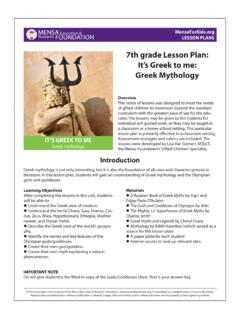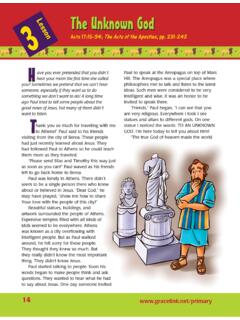Transcription of PowerPoint Presentation PROVIDING EFFECTIVE …
1 PowerPoint Presentation PROVIDING EFFECTIVE FEEDBACK: POSITIVE AND NOT SO POSITIVE. Patrice McGuire Senior Consultant McGuire Business Partners Sussex, Wisconsin (414) 234-0665. August 7 - 9, 2017. Patrice McGuire PROVIDING EFFECTIVE FEEDBACK: POSITIVE AND NOT SO POSITIVE. OBJECTIVES. Identify the gap between expectations and actual performance and behavior Capitalize on unplanned feedback moments Prepare for and conduct EFFECTIVE feedback discussions using the feedback process Personalize your approach based on the situation and the person Plan for difficult or sensitive conversations Identify actions steps with the employee and hold them accountable Omit using POWER as a way to coach and motivate 1.
2 CHECK THIS OUT . I put in as little energy and effort as I can get away with, without getting fired.. 44%. THE LAW OF LIMITED PERFORMANCE. People soon discover the level of performance their managers will settle for and gravitate to that level. Managers then assume that's all that people are capable of achieving, so they accept it as fact and quit challenging their people to get better. So each reinforces what the other believes. 2. FEEDBACK. The idea is . That the best way to succeed as a manager is through the success of your people. FEEDBACK IS: PROVIDING a reaction, positive or not-so-positive.
3 3. COACHING IS HAVING . The motivation to teach, build, and challenge people to become their best. The wisdom to understand that people matter and relationships matter. The willingness and ability to help people grow. The character to model moral principles, honesty, integrity, trust and sincerity for people. I don't HAVE TO coach .I GET TO coach others. COACHING. People will allow you to lead them to the level they trust you. People leave managers more than they leave companies. Idea: Build your people and they will build your organization. 4. FEEDBACK IS . A skill that is necessary for leaders.
4 A way to improve business results. Collaborative. Fact-based. Asking questions and listening. Building stronger relationships. Positive and improvement oriented. Frequent. Helping people to succeed. FEEDBACK IS NOT . Constructive criticism. Bad attitude . Yelling at others. Making others Learn a Lesson . Punishment. Focused on what others are doing wrong. Giving orders. Your side. Personal. 5. WHEN DO YOU PROVIDE FEEDBACK? When you want something to change. When you want something to continue. When you are doing something wrong. When you are doing something right. ALL THE TIME!
5 !! SET THEM UP FOR SUCCESS. 1) Set Clear Expectations 2) Address the GAP . 3) Hold People Accountable 6. SET CLEAR EXPECTATIONS. To what degree have expectations been established and communicated? How involved was the employee in establishing expectations? Did you both agree on the expectations? Does the employee know what he/she is being held accountable for? To what degree do you have confidence in this employee? ADDRESS THE GAP. What was expected? GAP. GAP. What was reality? 7. GAP CAUSES. 1. Structural policies, procedures, infrastructure 2. Resources time, money, people, technology 3.
6 Expectations agreed upon, accountable 4. Personal personalities, communication styles ADDRESS THE GAP. Please Read: Address the Behavioral Variance, pg. 8. The 360 Root Cause Investigation, pg. 9. 8. THE POWER TO COMMUNICATE. Where Our Message Comes From Words 8%. Voice, tone, Body languge, pitch, pace, position, volume gestures, eye 37%. contact 55%. HOLD PEOPLE ACCOUNTABLE. Your Communication Tendencies Aggressive Passive-Aggressive Assertive 9. AGGRESSIVE. In your face. Sense of superiority. Use of Power. Tend to blame others. Villain mindset. Raise their voice. Sounds like, You, You, You.
7 An another thing . You, You, You.. Monologue they do all of the talking. PASSIVE AGGRESSIVE. May not speak their mind. Silent treatment or walk away. Lack self-confidence. Victim mindset. Don't talk it out but may act it out. Focus on they , them , those . Little or no dialogue. 10. ASSERTIVE. Self confident. Asks thought-provoking questions. Listens and is open to ideas of others. Seek for understanding. Sounds like, We , Us , or Together . Engages with the spirit of curiosity. Equal dialogue. BEHAVIORAL BASED FEEDBACK. FACT What you SAW or HEARD. OPINION What you THOUGHT about what you SAW or HEARD.
8 11. ATTITUDE PROBLEM. You want attitude? I'll give you attitude!!! FEEDBACK PLANNING PROCESS. Prepare Share Ask Listen Action Praise 12. PREPARE. Review any previous coaching session notes. Make sure you have factual data to share with employee and/or specific examples. Anticipate their communication style and how they might react or respond. Use the coaching planning worksheet to stay on task. Net the issue out in one sentence in your mind. Make sure you are in the right frame of mind. SHARE. Start with an opening statement. Share your motive. Share the gap between what was expected and what was reality.
9 Reference the facts or examples so the employee knows exactly what you are talking about. Keep your emotions in check. Stick to the facts. 13. ASK. Invite them to reply. Ask one open-ended question to get the conversation started. Remain silent and allow them time to respond. Get them involved in the dialogue as soon as possible. LISTEN. To be a good listener, speak about 25% of the time and listen the other 75%. When asking the employee a question, the next best thing you can do is be quiet and let them respond. Pay attention to their words, tone, voice and body language.
10 Guide and question them and help them to discover their own answers. 14. ACTION. Discuss constraints, problem areas, barriers or needed areas of improvement. Treat this as a conversation .goal of understanding. Ask them to commit to specific actions, results and timeframes. Clarify who will do what, by when, and how will you follow up. Keep the responsibility on their shoulders; not yours. PRAISE. Point out specific talents, skills and abilities they have that will help them reach their goals. Express your belief that they will do whatever it takes to be successful. Share potential you see in them that they don't see in themselves.









